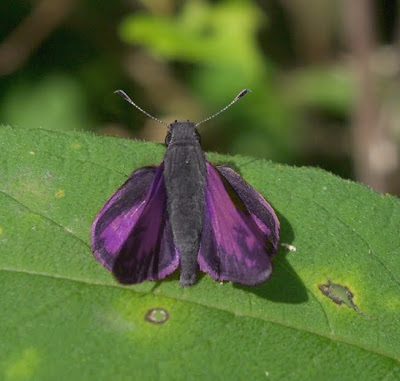Recent travels took me to Fernwood State Forest, near Wintersville, right on the eastern edge of the state of Ohio. It has been the only known nesting sight of an Ohio raven, one of the largest and most wary members of the Corvid family of birds. Unfortunately, no ravens were found on the trip, but we still had some interesting sightings. Four West Virginia White butterflies were spotted that day, but taking a photo of these ghostly little creatures is not so easy. Fast-fluttering and high-flying, it was a fortunate shot indeed that captured this specter's image. A bit smaller than the common Cabbage White butterfly, W.V.W.s lack the distictive black spots found on Cabbage White's wings.
Four West Virginia White butterflies were spotted that day, but taking a photo of these ghostly little creatures is not so easy. Fast-fluttering and high-flying, it was a fortunate shot indeed that captured this specter's image. A bit smaller than the common Cabbage White butterfly, W.V.W.s lack the distictive black spots found on Cabbage White's wings.
West Virginia Whites, Pieris virginiensis are considered, rare to occasional and quite localized in Ohio. Don't even try for them in Toledo or parts west, you won't find them there! Some of our earliest fliers, W.V. Whites are mighty particular about their chow as well. Here is the host plant you'll be looking for:

Cut-leaved Toothwort, Cardamine concatenata (used to be called Dentaria lanciniata) is a member of the mustard family. Now I did not note any toothworts at this location, but I did see several of its close mustard family relatives.
....
WV Whites are interesting flutter-bys and one you should note. In fact, the Cleveland Museum of Nature's LEAP program has been charting their occurrence. The invasive alien, Garlic Mustard may be impacting these little beauties in a very bad way. Forest fragmentation and loss of habitat are just a couple more reasons they are in decline. So, if you find some West Virgina Whites fluttering through your neighborhood, you might do a good deed and report them to the authorities!
 We enjoyed "in your face" views of a Cerulean, Kentucky, Worm-eating and Pine Warblers... and many more birds to round out the days list. A trip to the Eulett Center at the Edge of Appalachia produced Henslow's Sparrow and Chuck-will's-widow- a two life bird day for me!
We enjoyed "in your face" views of a Cerulean, Kentucky, Worm-eating and Pine Warblers... and many more birds to round out the days list. A trip to the Eulett Center at the Edge of Appalachia produced Henslow's Sparrow and Chuck-will's-widow- a two life bird day for me! The orchids are spectacular this year. Plenty of Pink and Yellow Lady's-slippers to be found here. And the more diminutive, Showy Orchis display is unlike anything I have ever seen. I saw more of these roadside beauties in one location today, than I have seen in the entire rest of my life. Was it a good day? Hm, does a bobcat skulk in the woods? Oh, and we saw one of those too!
The orchids are spectacular this year. Plenty of Pink and Yellow Lady's-slippers to be found here. And the more diminutive, Showy Orchis display is unlike anything I have ever seen. I saw more of these roadside beauties in one location today, than I have seen in the entire rest of my life. Was it a good day? Hm, does a bobcat skulk in the woods? Oh, and we saw one of those too!





































